As the sun crested the pines over Bayou St. John, Capt. Sam Glass had his doubts about the day ahead. First, when he stepped into his skiff after dropping it into the salt from his trailer, the bottom of the boat cracked audibly.
Ice.
During the night, the temperatures in Orange Beach hit 30 degrees. As Glass remarked, “Yeah … we don’t do that kind of cold down here.”
But an arctic blast sent the mercury into a free fall after the fog rolled in the night before. And freeze, it did.
“Normally, we’d take a ride,” Glass said as I and my fishing buddy for the day, Easton Colvin, grabbed seats on the boat. “But nobody wants to go full bore in this weather.”
Indeed, even after the bright Gulf Coast sun graced the emerald waters of the bay, it was still only 34 degrees. Even bundled up in sweatshirts and outer gear, if Glass were to push the 75-horsepower outboard to its limit, we’d freeze. As he eased the skiff out into the well-traveled channel, I could almost hear the gears spinning in his head.
This stretch of the Gulf Coast, as Glass puts it, is “easy to get to.” And in the summer, the boat traffic is intense. But today, on the coldest day of the winter (Colvin was good enough to remind me that my timing for visiting the beach was just a bit off), traffic was light. The cold, while it kept us from a far-flung run over to Wolf Bay or farther up into the Perdido River, did keep the boats in their slips.
It turned out to be a blessing in disguise. The mouth of the bay, where inland flows push out to the Gulf through a cut in the barrier islands of Perdido Key in Florida and Orange Beach in Alabama, is actually great habitat for redfish, among other inshore fish like spotted sea trout, sheepshead, whiting and black drum. The problem, Glass noted, is that the constant hum of boat traffic keeps these fish alert and wary. During warmer months, the captain said that redfish are almost wholly inaccessible to flats anglers–the boat traffic is just too thick to make fishing the area a worthwhile proposition.
But on this day, the sand and grass flats along the islands in the middle of the bay were gloriously empty of other boats, and Glass had a rare chance to put anglers on fish within sight of the boat launch.
Oh, but the cold. A double-edged sword. It worked in our favor to lighten boat traffic. It worked against us, dropping water temperatures into the mid-50s and stunning the bay’s game fish in the process.
I could tell by his body language that Glass was skeptical. As we motored slowly through the boat channel, he watched the adjacent flats with a troubled eye.
“Normally,” he said eyeing the point of a sandy island where the clear water pushed over the spit from one side of the flat to the other, “I’d be looking for fish to crest that bar. But right now, it’s just too cold. Our best shot is to try and find big reds laid up in the grass trying to warm up.”
Almost like clockwork, a well-hidden 10-pounder busted in the knee-deep water and bolted for the depths.
“Just like that,” Glass said. “Only we need to find the next one before he spooks.”
I grabbed an 8-weight and stepped up onto the bow of the boat as Glass climbed atop the polling platform. If the fish were going to that spooky for the rest of the trip, it was going to be a long day. I shared Glass’ skepticism–it might be a good day to spend at the Flora-Bama, gazing out over the Emerald Coast while sipping from a bottomless Bloody Mary.
But then the lesson in chasing pressured redfish started in earnest.
First, Glass explained, I was going to throw a long leader.
“You can get away with a six-foot leader in other places, but not here,” he said. “These fish get hit hard, and there’s so much boat traffic in the summer that it’s just not possible.” The leader on the rod I fished was closer to 12 feet.
Second, he explained, “Casts are free. If you see something that looks like a fish, cast to it. Don’t wait for it to bust out and disappear.” That second lesson was already burned on my brain after watching the big red run for deeper water as we eased up on it.
Lesson No. 3 was one I figured out on my own. After a slow hour or so, with water temperatures climbing from 56 degrees to 57 degrees, we started seeing fish. Not classic tailing reds pushing into the shallows, but schools of a dozen or more fish lurking on the cusps of ledges and deeper water. They were, indeed, wary. As I lifted my rod to cast out ahead of the first school Glass and I spotted, the spooky fish vanished into the deep green waters of the bay.
Casts were going to have to be long and tight. With fish this cautious, we’d have to find our “fish eyes” or we were going to spook every school we encountered.
Finally, I learned, in this clear water, these fish behaved very differently from redfish I’ve chased in the past. I thought about it and came to the conclusion that I needed to approach this from a more tropical perspective. I need to, at least in my head, pretend I was chasing bonefish on a Bahamian flat.
And that was key, because these schools of reds behave exactly like pods of bones cruising along a Caribbean flat.
And, after a couple of more encounters with schools of fish and a fly change, we connected with an 8-pound fish. Spunky and winter-skinny, it was the lead fish in a big school and it popped out of a group to gobble up a big purple streamer that Glass suggested I try.
Winter is a great time to chase big reds along the Gulf Coast – in the bayous of Louisiana, giant bull reds are legendary. But smaller, inshore fish school up along the Emerald Coast, and, even in cold weather, they can be caught. And, as Glass proved, if you give pressured fish some space and some access to solid habitat, they, too, will eat a fly.
As we motored back to the launch after a day spent playing with schools of fish, Glass was noticeably more relaxed. Foul weather is a guide’s worst enemy–it requires improvisation and creativity. That we both saw and caught redfish is a testament to his bona fides – it could just as easily have been a long day of casting with no fish to show for it.
“I’ll take it,” he said, as we reeled that long leader in after the last cast. “On a day like today … I’ll take it.”




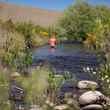
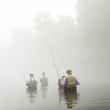

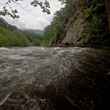



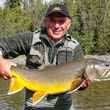



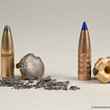
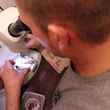




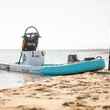



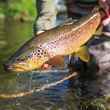
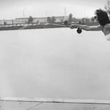

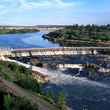

Comments